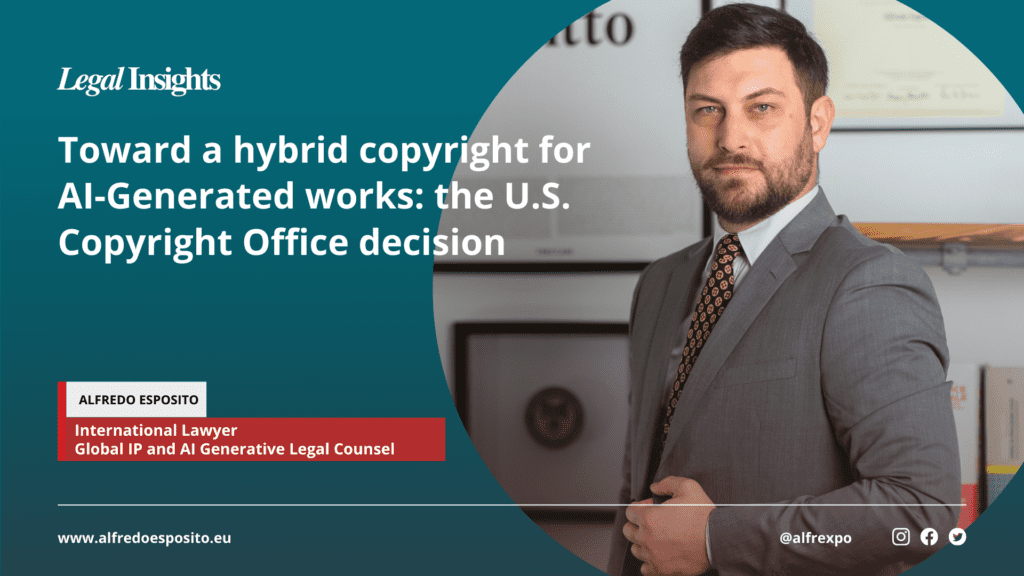
The rapid expansion of Artificial Intelligence applications is at the center of a heated debate between proponents of free use of AI-generated content and proponents of more orthodox copyright protection theories.
Restrictive Positions on Derivative Graphics Generation Software
The most restrictive positions hold, for example, that derivative graphics generation software such as Midjourney, Dall-E, or Stable Diffusion are endemically illegitimate, being able structurally to function only through mass infringement of copyrighted content.
In support of this thesis, for example, the European Guild for Artificial Intelligence Regulation was born, a project conceived by cartoonist Lorenzo Ceccotti and MeFu – Mestieri del Fumetto to take action on the proposed “AI Act” regulation under consideration by the European Commission.
And it is from the world of comic books that comes an important decision from the United States Copyright Office, which has changed an earlier decision and re-regulated the scope of registration of a comic book generated through the Midjourney Artificial Intelligence app. It is important to note that although the U.S. federal courts are not bound by the Copyright Office’s decisions, the theoretical evaluations it provides are nonetheless a useful reference point for judges who must deal with issues related to works produced by generative AI during any litigation.
The original application for registration, made on September 15, 2022 by author Kristina Kashtanova in connection with the comic book “Zarya of the Dawn” had obtained full and complete registration of the work.
Il copyright office statunitense aveva successivamente preso atto dai social media che il fumetto era stato creato utilizzando l’intelligenza artificiale di Midjourney.
This substantive element was the basis for a new determination regarding the registration of the comic strip. The result of the final assessment on the elements deserving protection is undoubtedly significant and analyzes in a very detailed and technical manner the creation of content by means of the artificial intelligence app. It is stated in the motion that, “Ms. Kashtanaova is the author of the text as well as the coordination, organization of the textual work and visual elements. All of this is protected by copyright. In any case, the images included in that work were generated by Midjourney technology, and are not the product of a human author. Since the registration did not state the presence of Midjourney-generated content, we intend to cancel the original certificate and issued to Ms. Kashtanova, and issue a new certificate covering only the expressive material she created.”
Since the application for registration had not disclosed the use of artificial intelligence, the Office therefore determined that the application was incorrect or, at least, substantially incomplete.
Reading it this way, it would seem to be a bureaucratic matter, but the U.S. Copyright Office instead intervenes on the merits of the case as well. Indeed, the decision states that the images generated by Midjourney are not protected by copyright because they are not produced by a human authority. Under U.S. copyright law, only original works of authorship created by a human authority are protected by copyright.
The document indicates that the images created by Midjourney are the result of a mechanical and not a creative process, and that these cannot be considered copyrighted works.
The interpreter arrives at this assessment by arguing that Midjourney “does not understand grammar, sentence structure, or words as humans do,” but “converts words into small pieces, called tokens, which are compared to training data and used to generate an image” and this implies that “the process by which a Midjourney user obtains a satisfactory image through the tool is not the same as that of a human artist, writer, or photographer.”
While the protection of individual images (and related prompts) is thus rejected, the Copyright Office instead recognizes as deserving of protection the creative aspect of the overall work with regard to such elements as organization, conception, and overall concept.
The decision also underscores an important step that would make works produced by Midjourney susceptible to protection: this could occur, for example, where a significant modification with a graphics processing program like Photoshop would give the work a “sufficient amount of original authorship.” A nuance that theoretically sets up a flexible but well-defined legal axis.
Thus, a hybrid form of copyright, which protects the entire skeleton of the work, but not its individual constituent parts, which are regarded as structural elements lacking ownership in the owner of the work itself, seems to be gaining ground.
This interpretation could also be extended to other artificial intelligence models such as Chat GPT, Dall-E, and Stable Diffusion, and copyright protection would then be affected by the balance between human and AI-generated input, creating a potentially fluid legal framework.
From a legal perspective, the U.S. Copyright Office’s “lateral” step appears consistent with existing U.S. copyright and Fair Use laws, although it has raised some concerns that this decision may curb innovation in artificial intelligence and unduly limit the ability to obtain royalties for AI-generated works.
What is the European line?
On December 6, 2022, the Council of the EU adopted its proposal with a common position on the AI Act, aimed at introducing European regulation on artificial intelligence (AI) systems. The substantial novelty of the European approach to artificial intelligence, compared to the U.S. approach, is in having established a classification of AI systems according to the risks they pose to fundamental rights.
From a copyright perspective in relation to the “token” content that makes up and feeds AI models, the Copyright Directive 2019/790/EU introduced the “Test and Data mining” exception, allowing the massive extraction and reproduction of digital data provided that the rights holders do not reserve the use of the exclusive rights to content for purposes other than those of which the user has justified it.



